- Entrepreneurship Handbook
- Posts
- I Studied 13 Successful Company Rebrands. Here’s What I Learned
I Studied 13 Successful Company Rebrands. Here’s What I Learned
Turns out, you actually can put lipstick on a pig
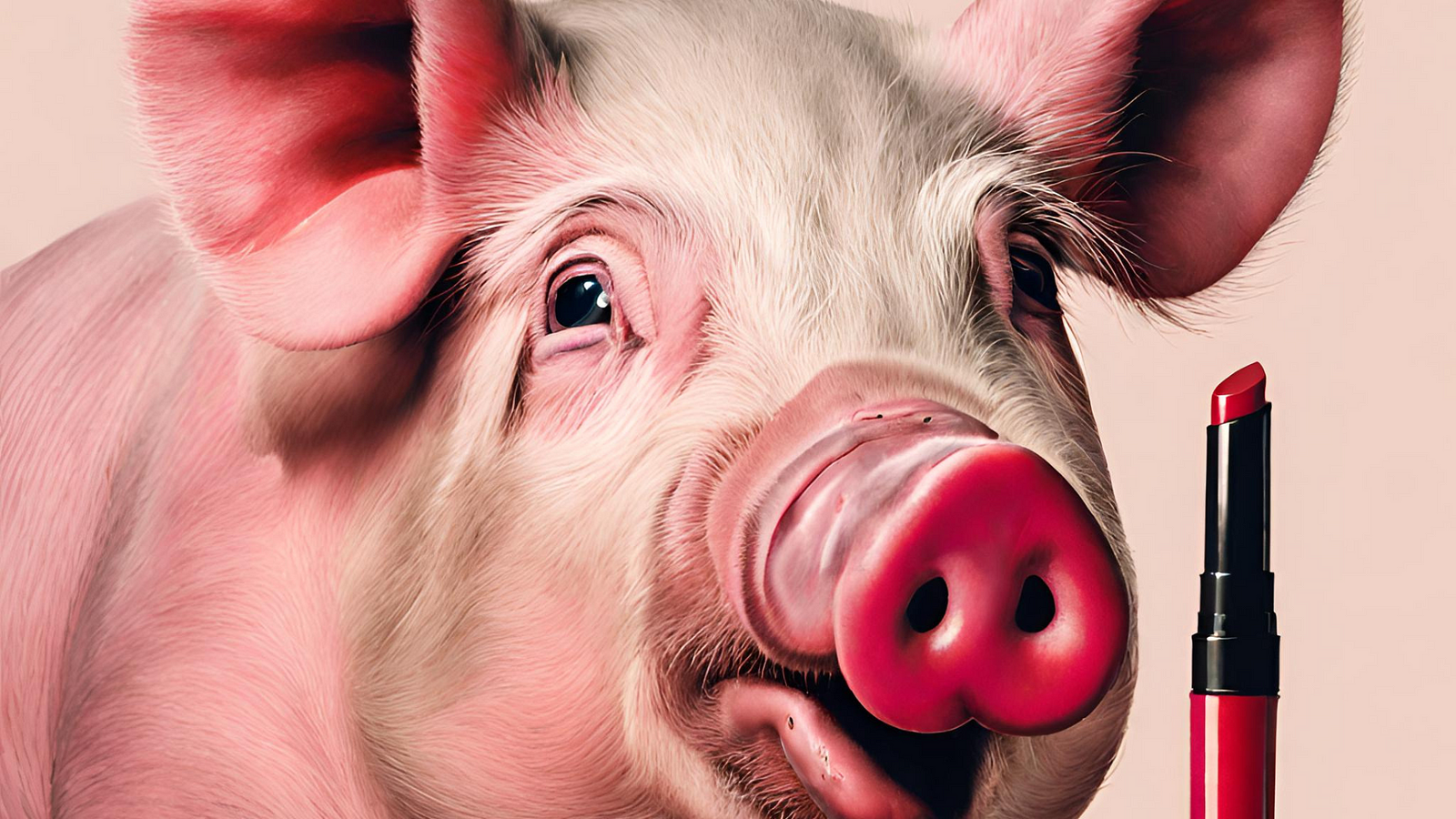
A pig with lipstick on
“Rebranding is frickin’ stupid.”
Kipp Bodnar, CMO of Hubspot is debating Kieran Flanagan, CMO of Zapier, on their podcast Marketing Against The Grain, right around when Elon Musk rebranded Twitter to X.

Kipp Bodnar, CMO of Hubspot debating with Kieran Flanagan, CMO of Zapier
“I believe a rebrand is the public manifestation of internal confusion,” says Bodnar. “Never do it.”
Flanagan is more open to it. He sees the logic of a rebrand if a company has outgrown its brand. He gives the hypothetical example: if a company called “Calculator.com” evolves into selling more than just calculators, a rebrand makes sense.
Both men name many terrible rebrands, including:
myTaxi to FREENOW. It went so poorly, they had to publish a Medium article dispelling the myths behind the new name.
RadioShack to “The Shack.” The electronics retail store has unfortunately devolved into private equity’s plaything that shacks up on the next one’s balance sheet.
American Express Financial to Ameriprise. Today, Ameriprise is ranked 245th on the Fortune 500 and is on the list of largest banks in the United States, so as far as corporate spin-offs go, this one kind of worked out. Similar case study: IBM’s spin off of Kyndryl)
But they can’t state one example of a good rebrand. They say “a non-trivial amount of time went into the research for this show,” but they were at a loss.
They appeal to the crowd for help. “Could someone please in the comments tell us about a good rebrand?”
Finally, they come up with two examples, but refuse to call them rebrands:

The logo of Google’s underplayed parent company, Alphabet (abc.xyz)
The quiet creation of Google’s holding company, Alphabet.
The “modification” of Dunkin’ Donuts brand name to Dunkin’.
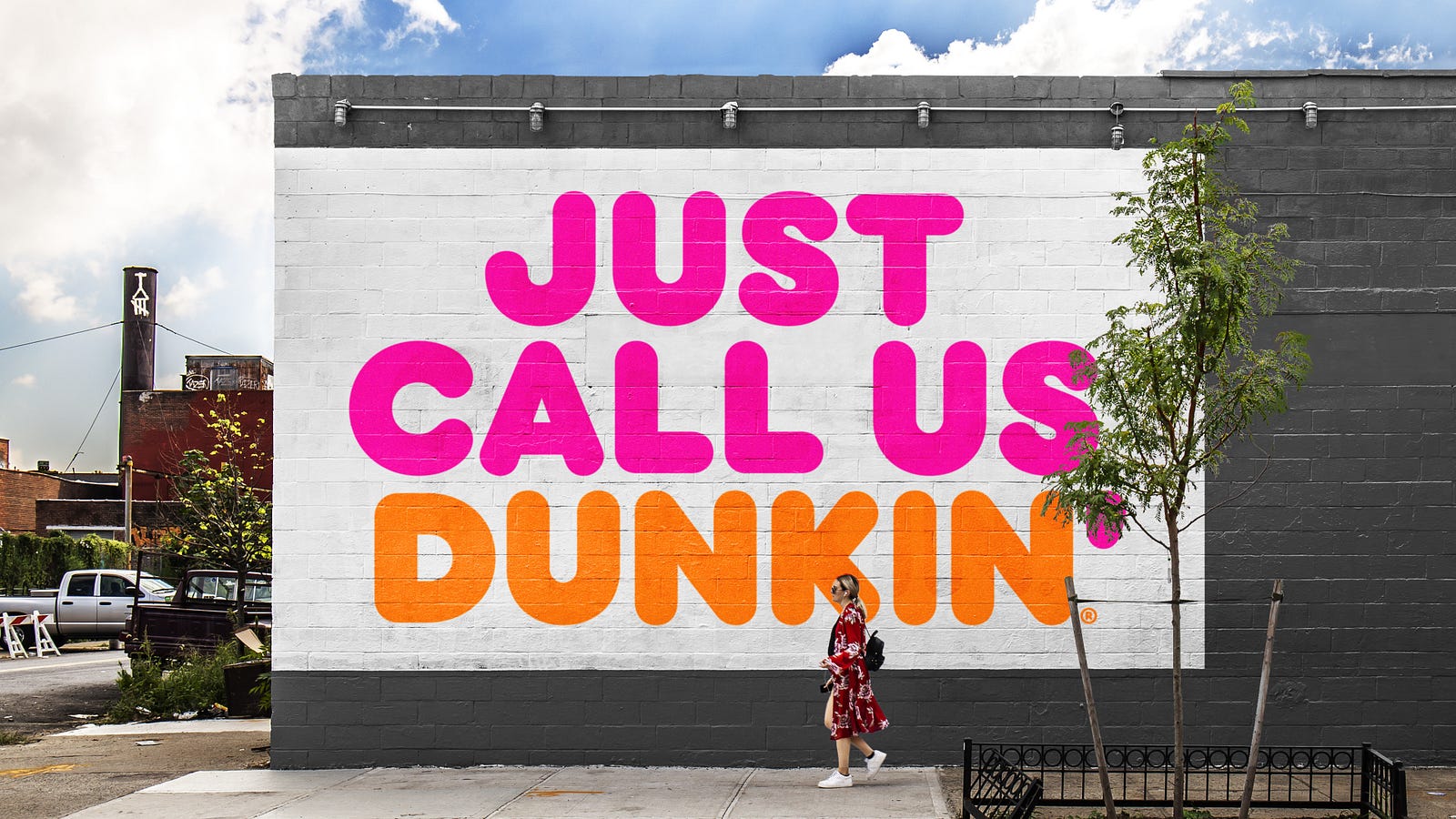
Dunkin’ Donuts subtracted “Donuts” from his brand name to be just “Dunkin’”
The show ends with neither Bodnar nor Flanagan being able to come up with even one successful rebrand story.
Their conversation focused almost purely on the disaster of the Twitter/X rebrand (I agree it was a mistake to rebrand Twitter to X, more below) and was missing rich examples and practical takeaways for companies thinking about rebranding.
Hence, this article.
This article dives deep into rebranding examples, some that haven’t been written about, and you’ll come away with a handbook for your own company rebrand strategy, including a list of principles and takeaways at the end.
Note: By “rebrand” I mean a full “rename” not just “redesign.” A redesign is much less risky. We’re talking about the whole cannoli.
Another note: This article focuses on company rebrands, not product rebrands.
13 Examples of Company Rebrands That Didn’t Fail (Arguably)
And takeaways to apply to your own rebrand process.
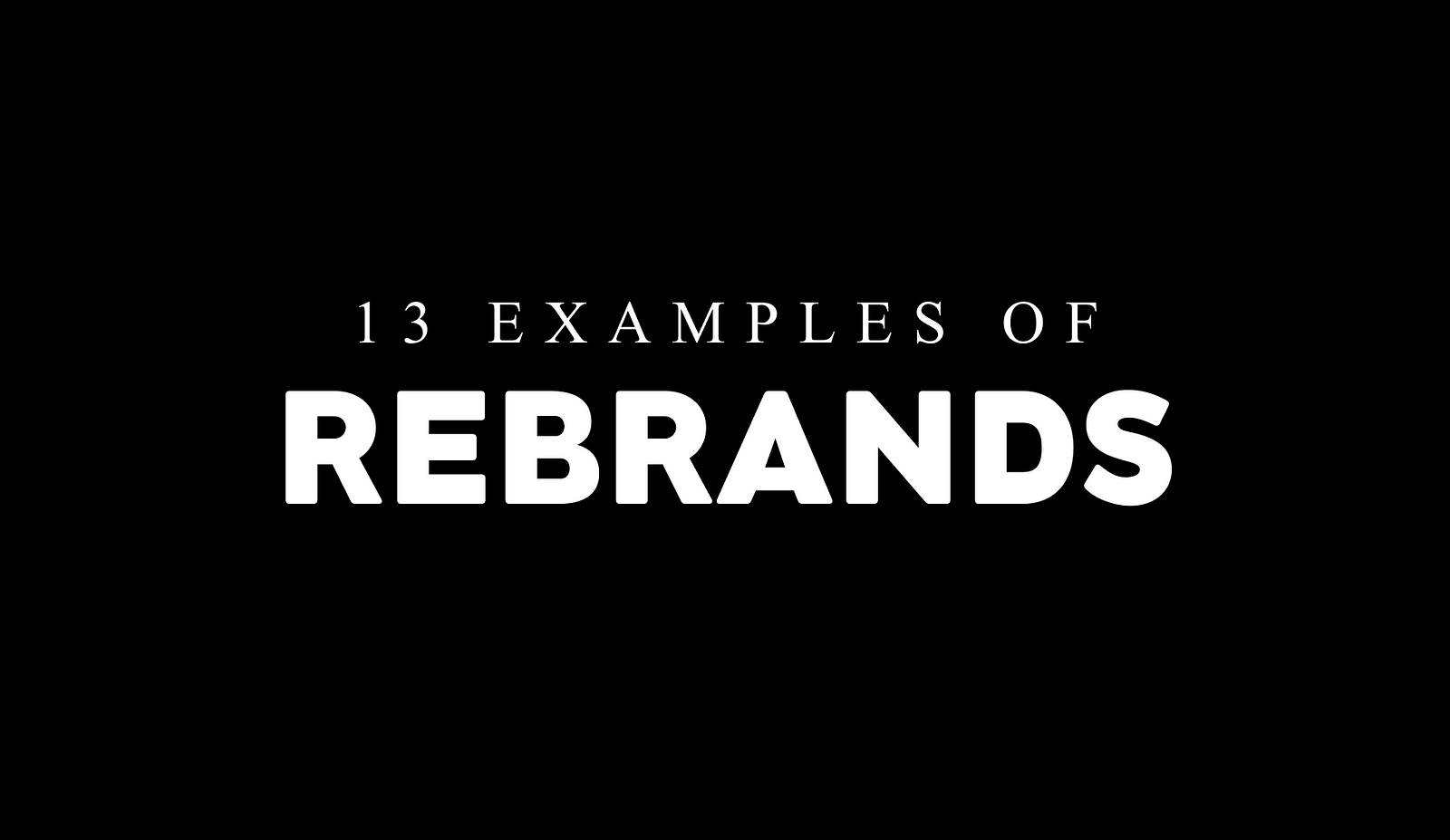
by Entrepreneur’s Handbook
1. Expand the brand to offer more product lines

TripActions rebrands to Navan
Similar to Flanagan’s hypothetical “calculator.com” example, travel tech company TripActions rebranded to Navan, to better encapsulate the company’s broader spate of services, beyond just “actions you take on a trip.”
P.S. Don’t do this 🙈
Oddly, the company published a press release entitled “Navan Re-Rebrands Back to TripActions” with the subhead “CEO Ariel Cohen Apologizes for Customer Confusion, Day-Drinking.” Not only did the April Fools joke not go over well on Twitter, it now ranks atop Google for anyone searching “Tripactions rebrand Navan.” With no “this is a joke” messaging, readers may be mislead.
💄 Takeaway: Rebrands are inherently messy. Do yourself a favor and don’t make them even messier.
2. Buy and resurrect a bankrupt household brand
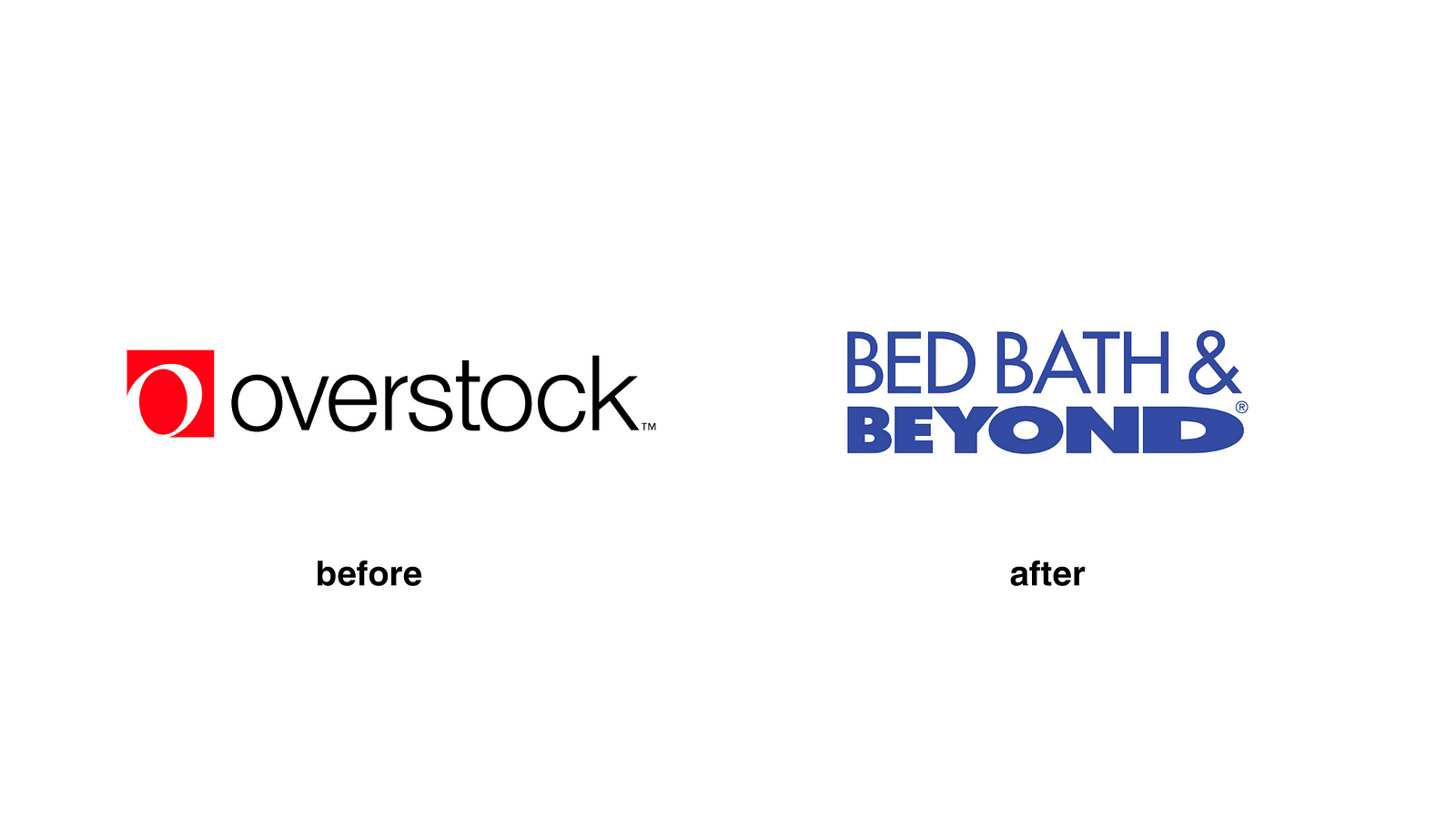
Overstock rebrands to Bed, Bath & Beyond
Overstock.com is now Bed Bath & Beyond. Overstock acquired the bankrupt home-goods brand Bed Bath & Beyond for $21.5 million in June. The acquisition included Bed Bath’s intellectual property and digital assets. Overstock’s website relaunched as BedBathandBeyond.com, merging Overstock’s online business model with popular branded products from Bed Bath & Beyond. Shoppers who visit Overstock online are redirected to BedBathAndBeyond.com.
💄 Takeaway: If the choice is between two recognizable brands, choose the one that’s more extensible; it’s less boxed in to one market, and has the optionality to expand beyond into larger markets in the future.
3. Assume a top product’s brand

Clear Channel rebrands to iHeartMedia
Clear Channel renamed to iHeartMedia in September 2014. The company announced that it would be renamed to iHeartMedia — after its prolific brand iHeartRadio — to reflect its multiplatform presence and ability to embrace innovation and new technology. The new name also reflects the company’s growing emphasis on digital media and internet radio.
💄 Takeaway: Aligning the broader company around your top performing product can provide your brand with a stronger overall focus.
4. Reflect a pivot to find product market fit
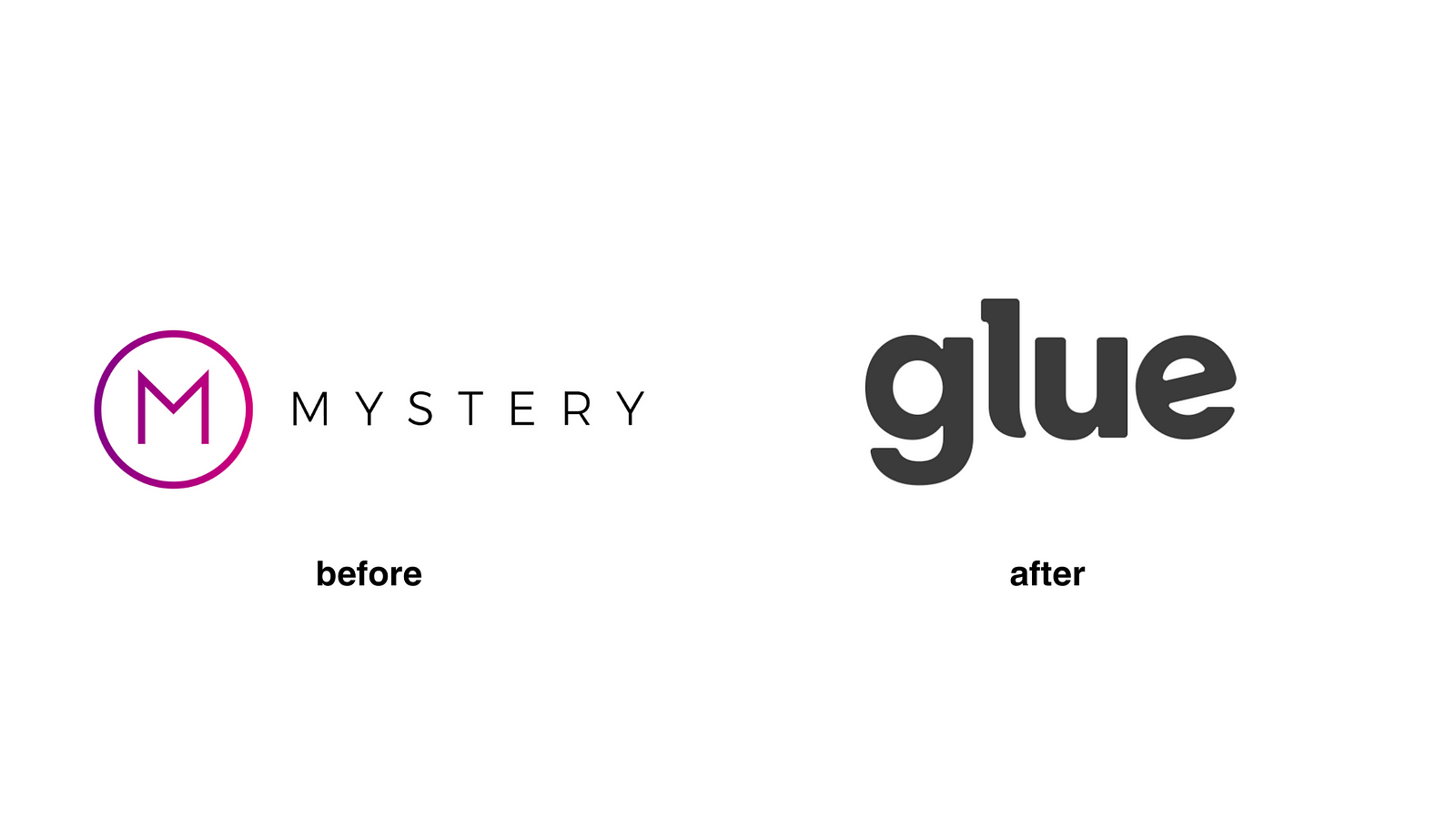
Mystery rebrands to Glue
Virtual events platform Mystery renamed to Glue after five years to focus more on where it found product market fit as an HR tech company, symbolizing its leap from B2C to B2B.
💄 Takeaway: Transitioning from B2C to B2B (or vice versa) to find product market fit is a big move. A rebrand can help anchor your pivot and make that transition clear.
5. Merge two brands into one big brand
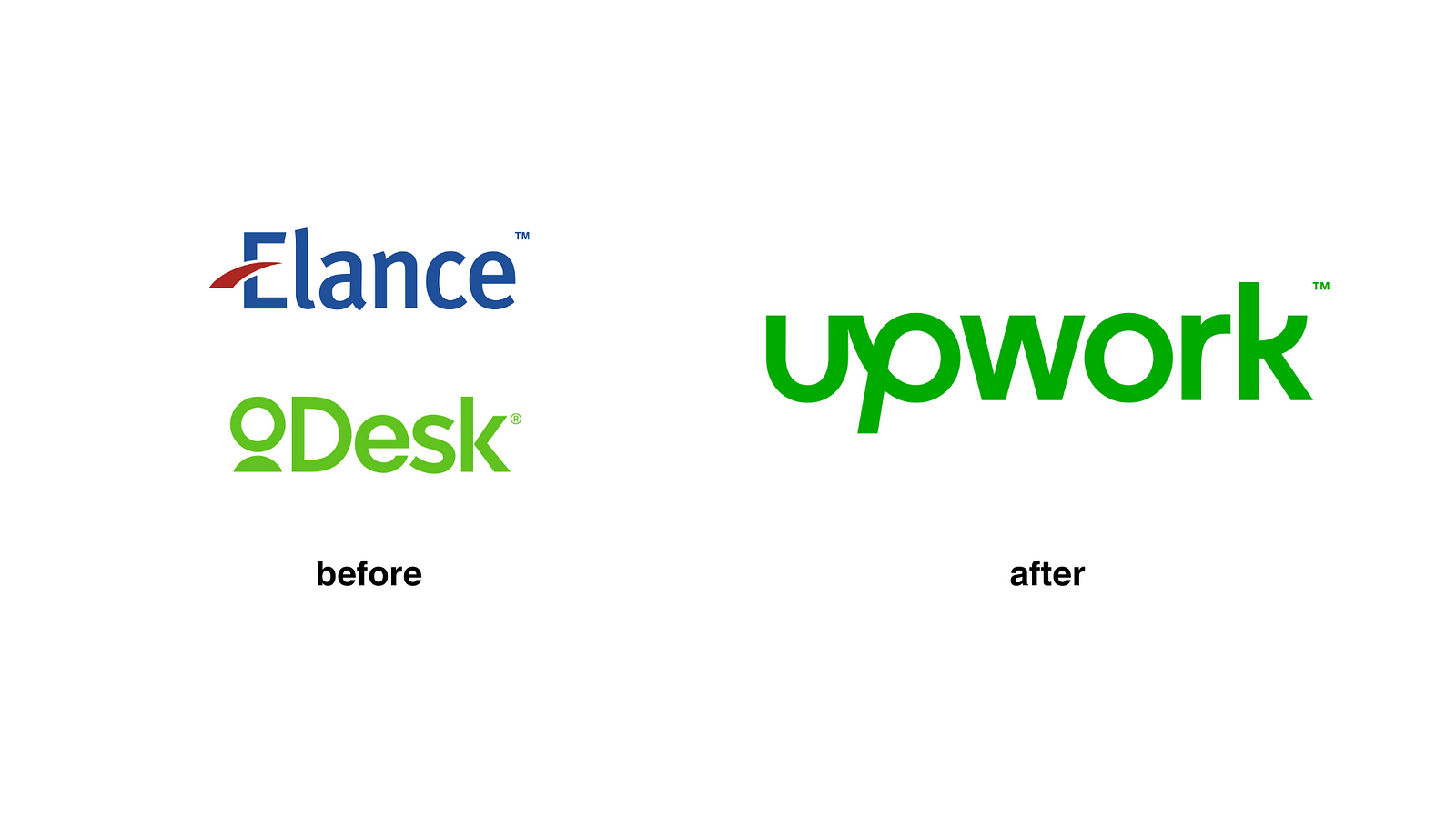
Elance and oDesk merged and “relaunched” as Upwork in 2015. But their announcement focused not on the rebrand, but on new product offerings and the size of the market.
💄 Takeaway: Upwork is probably the best example of not putting lipstick on a pig, but actually 10Xing the value proposition to such an extent that both pre-existing brands were too small and established to do justice to the new product offerings, so a “bigger” brand needed to be created.
6. Create distance from the founder
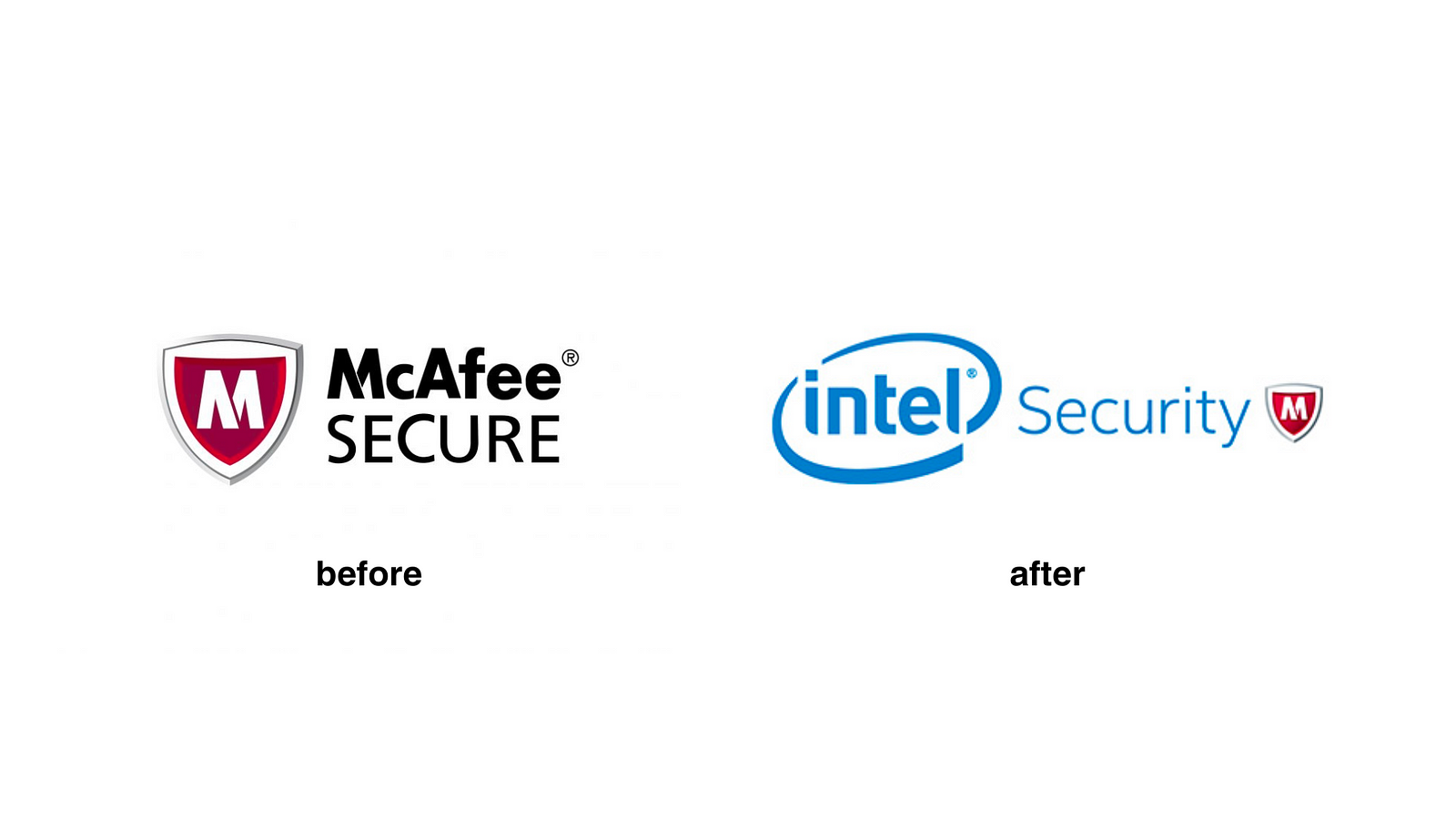
McAfee rebrands to Intel Security (and back again)
McAfee >> Intel Security. More than four years after Intel acquired computer security software company McAfee for almost $8 billion, Intel ditched the McAfee name and donned “Intel Security” instead. On one hand, Intel wanted to better align itself with the security fraternity. But perhaps more than that, McAfee founder — John McAfee — had become a controversial figure, chiefly around an alleged murder in Belize which resulted in (John) McAfee going on the run for a while. However, it didn’t last long. In 2017, Intel spun out McAfee and brought the brand back.
💄 Takeaway: When a brand is too well-established, it may be too late to bring it into a branded house. Counterexample: Anchor rebrands to Spotify for Podcasters.
7. Subtract a word to expand into new markets

Apple Computer rebrands to Apple
Apple Computers, Inc. >> Apple, Inc. In 2007, Steve Jobs announced that the company was dropping the word “Computer” from its name to better reflect their move into a wider field of consumer electronics. “The Mac, iPod, Apple TV and iPhone. Only one of those is a computer. So we’re changing the name,” he said. Might be where Dunkin’ got the idea?
💄 Takeaway: Start focused on your niche, whether it’s donuts or computers, then lop off the niche word to make your brand multi-vertical.
8. Wash away bad press (or try to)
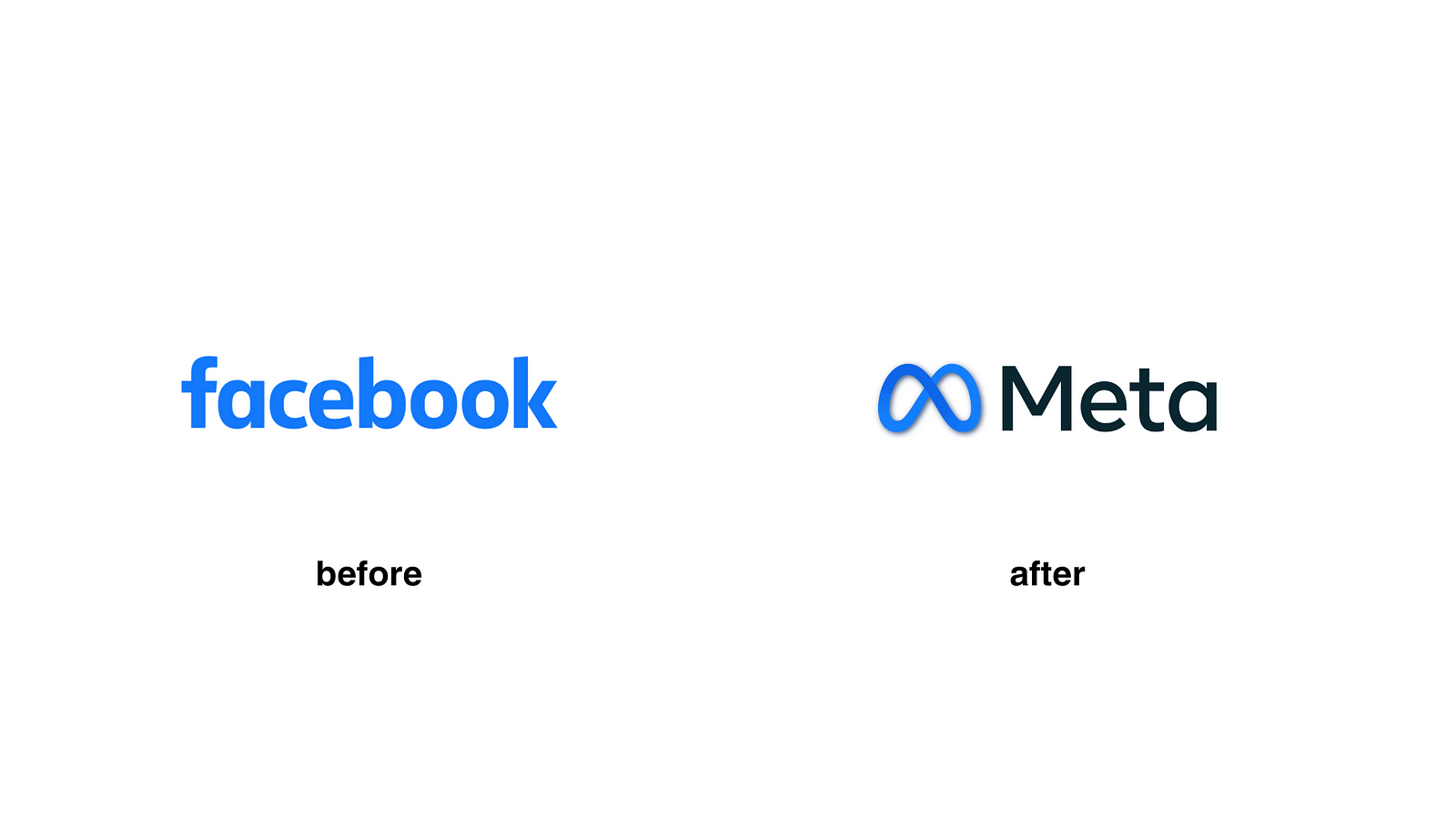
Facebook rebrands to Meta
Facebook’s rebrand to Meta. Chief product officer Chris Cox said the name change was successful, explaining his measure of success was the amount of press coverage of the name change compared to the whistleblower disclosures. As Eric Schiffer, CEO of private equity firm The Patriarch Organization, said of the name change: “It is absolutely a genius move to shift away, to rebrand to the metaverse, and wash away the past pain.”
💄 Takeaway: What’s painful in the immediate term may pay off in the longterm. The creation of a holdco brand helped separate an original product from an evolving company.
9. Eliminate confusion among multiple business units
A new brand with the same mission: Leading the future of aerospace and defense. Raytheon Technologies is now RTX. #OneRTX rtx.com/wearertx?utm_s…
— RTX (@RTX_News)
Jun 17, 2023
Raytheon merged with United Technologies Corp and its iconic Pratt & Whitney jet engine brand in 2020, becoming known as RTX Corp. “It’s designed to reflect our recent realignment from four business units to three,” Chris Johnson, senior director of global media relations at RTX, said. “The new name reinforces that we are an integrated aerospace and defense company; communicates to our customers that we are one company built from three industry-leading businesses (Pratt & Whitney, Collins Aerospace and Raytheon); and eliminates confusion between the company name and the Raytheon business unit.”
💄 Takeaway: Raytheon is a good example of how a holdco brand should elevate and support the business units, and not the other way around, because the business units drive direct revenue, not the holdco. The holdco is only a shell.
10. Launch a new product and company vision
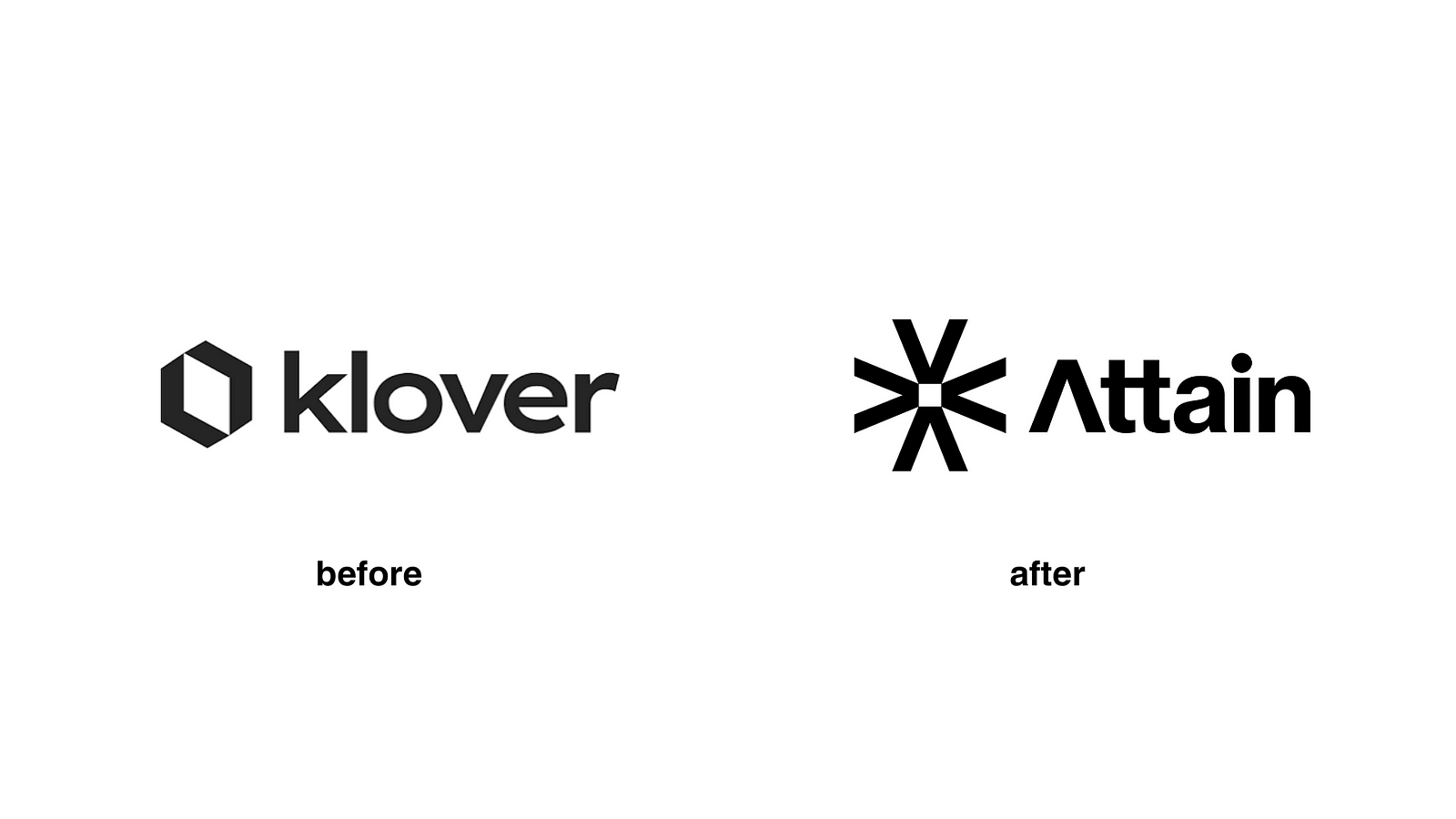
Klover rebrands to Attain
Klover >>> Attain. In their November 22, 2022 press release, Attain used their Series B funding announcement to reveal its new name and new vision for the company, including a new SaaS platform announcement.
💄 Takeaway: Bundle the rebrand with an early funding announcement before growth really takes off. Press like to cover funding announcements so it’s a cost-effective vehicle to get the word out.
11. Just shake things up
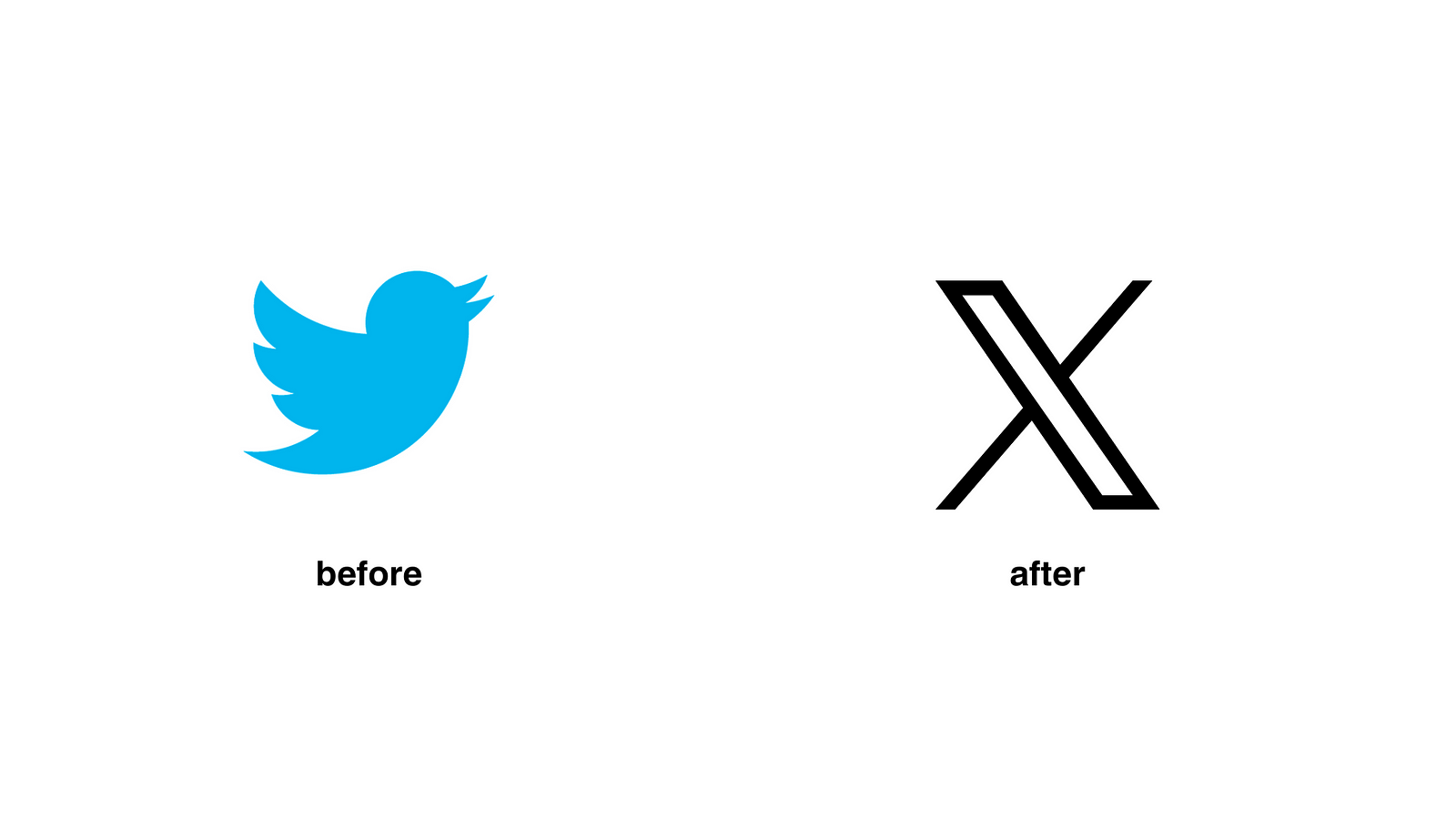
Twitter rebrands to X
Twitter renames to X — in perhaps the most poorly received rebrand efforts in recent history, Twitter’s new owner Elon Musk rebranded the iconic “blue bird” social platform to “X” — and has since received a lot of negativity and reluctance from users to adopt the new brand. Musk stated he plans for X to “add comprehensive communications and the ability to conduct your entire financial world” via his “everything app.” It could end up being very smart longterm, but so far, it hasn’t caught on.
💄 Takeaway: Rebrands are inherently messy, but doing it suddenly or in a jarring, fleeting manner will garner backlash. Especially if your brand is highly visible like Twitter, it’s worth investing in a story narrative people can believe in.
12. Turn your pre-marketing into a real business
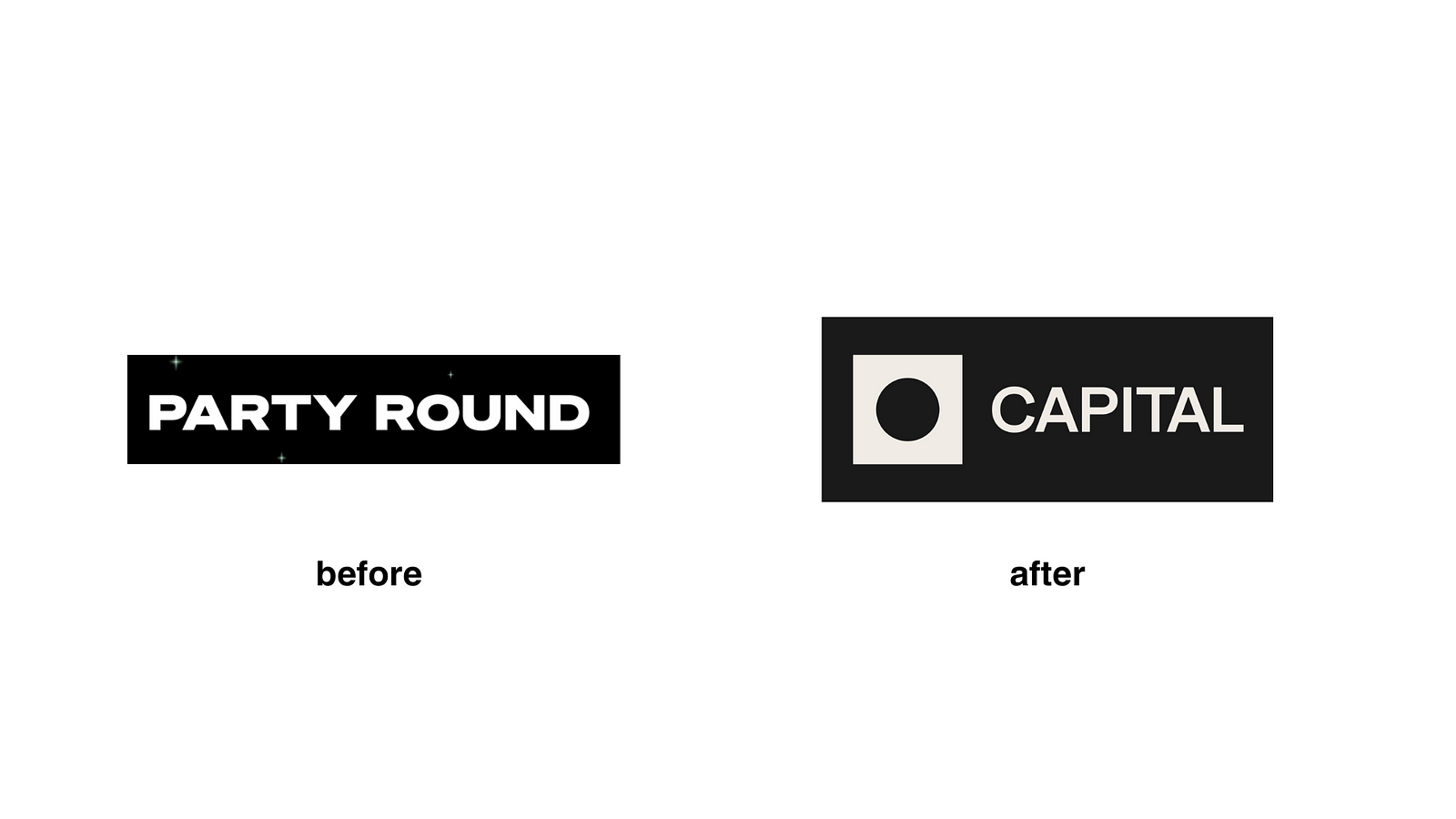
Party Round rebrands to Capital
Party Round rebranded to Capital, a fintech focused on funding tools for founders. Before, Party Round focused on pure marketing. Now, it’s focused on its product. The cofounders explained their rationale to TechCrunch:
“Party Round was this amazing, living breathing meme that was evolving and meant to entertain the community. But the thing is, even our ambition as a company, and what we want to do on the product side, is [different].”
💄 Takeaway: Build buzz and community with marketing stunts and when it’s time to get laser focused on the business model and product, launch a rebrand to signal the new path forward.
13. Evolve from Consumer to Enterprise
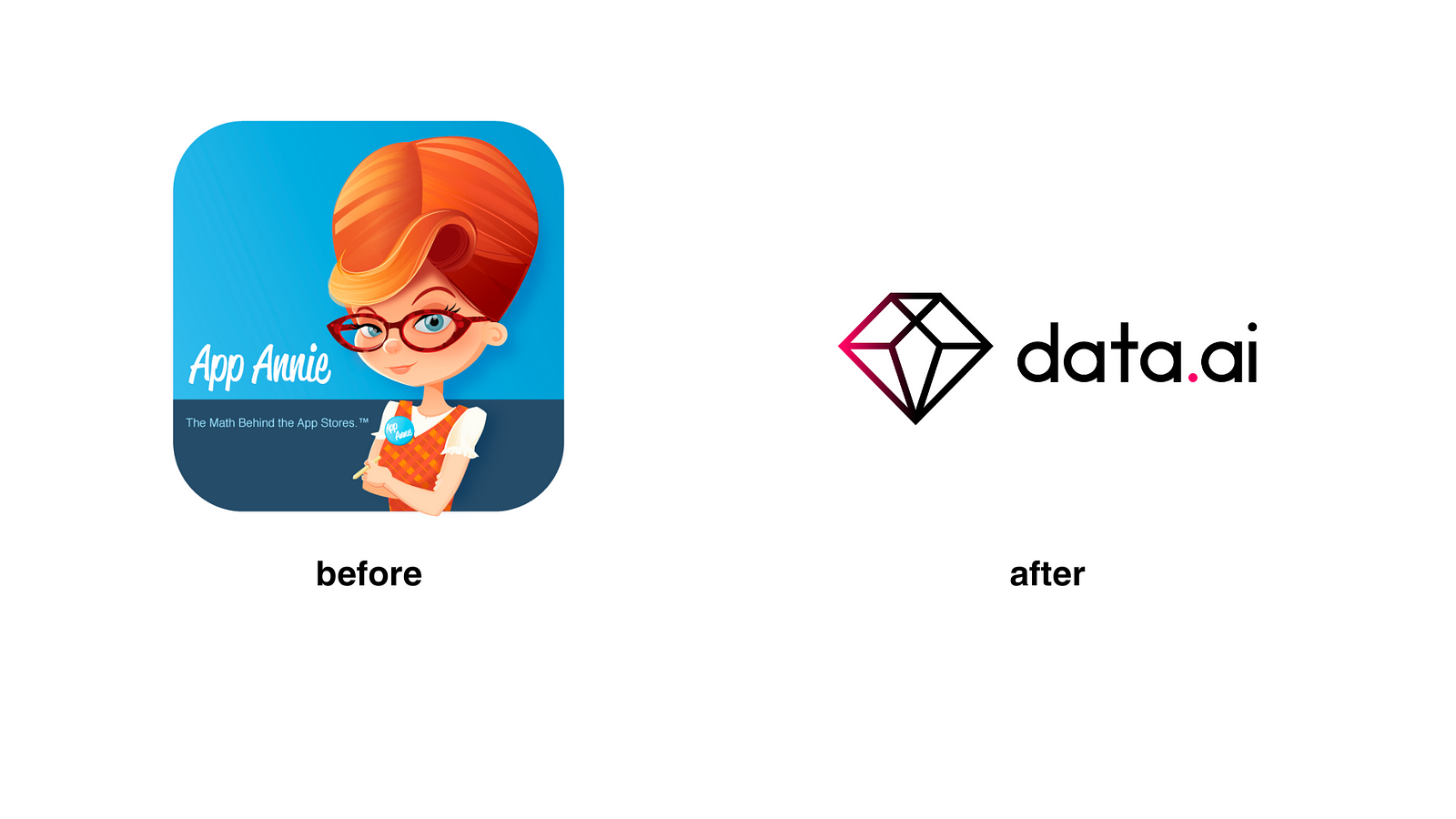
App Annie rebrands to Data.ai
AI took App Annie’s job. App Annie rebranded to Data.ai, in a move to reflect a a shift from consumer app data analytics to a more comprehensive enterprise-focused suite of offerings. One review named it “painfully generic.”
💄 Takeaway: Mascots are difficult to replace, as users become endeared to them over the years. Maybe Data.ai could have brought Annie along in a creative way? Perhaps as a guide? I agree the new brand is dastardly cold compared to Annie.
8 Tips: How to Succeed With Your Rebrand
Don’t rush it. Spend months thinking through the new brand narrative and craft it into a compelling story. Hire a professional third-party consultant if you don’t feel confident in doing it in-house.
Bring everyone internally along first. Do a 1:1 roadshow with key individuals in the company to give them a preview before the all hands. If your employees don’t believe in the new brand, what makes you think your customers or the market will?
Establish a central knowledge hub with FAQs and talking points for everyone internally to refer to.
The most important person in a rebrand is the CEO. He or she has to be all-in, as they are going to be the main person preaching the story over and over again. If you get the CEO’s buy-in, everyone else will follow.
To pick a name, check for competition, domain availability, CEO reaction, and trademark difficulty — in that order.
Once you nail the narrative, promote the hell out of it.
Create a sense of stability for analysts and investors. Create predictability for employees. Leave zero room for disruption of customers.
Ignore the name bashers. Everyone is different. Everyone has an opinion. After all, it’s better to be noticed than forgotten.
In the end, remember that rebrands are tough. It’s a big change. For everyone. And people don’t like change when they didn’t ask for it. So give yourself grace. Have patience. Public relations events always blow over and pass within a few days (or weeks).
If you found this handbook helpful, please share it on Linkedin and subscribe to our newsletter to receive future handbooks at ehandbook.com/subscribe.
